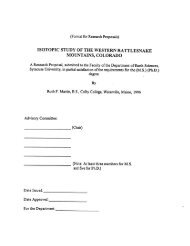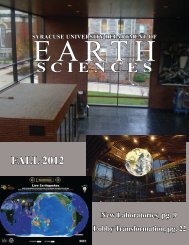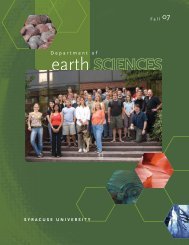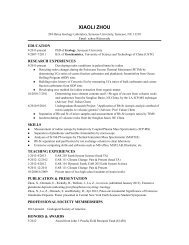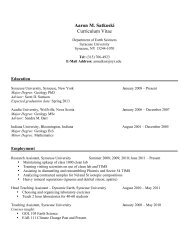alumni reception - Syracuse Universe Department of Earth Sciences ...
alumni reception - Syracuse Universe Department of Earth Sciences ...
alumni reception - Syracuse Universe Department of Earth Sciences ...
Create successful ePaper yourself
Turn your PDF publications into a flip-book with our unique Google optimized e-Paper software.
from Caitlin Keating-Bitonti’s thesis (B.S. 2009)<br />
is also submitted for publication, and relates work<br />
with Pr<strong>of</strong>. Scott Samson, and also colleagues at<br />
Yale University (Hagit Affek and Peter Douglas), to<br />
establish paleotemperatures in the Gulf Coast during<br />
the early Eocene climatic optimum, the warmest time<br />
in the Cenozoic. Caitlin’s high-resolution isotope<br />
work on fossil bivalves, combined with multiple other<br />
independent geochemical proxies for temperature,<br />
provides one <strong>of</strong> the most strongly supported estimates<br />
yet published, and yields values somewhat cooler<br />
than expected at low latitudes during this interval.<br />
Manuscripts with two other former students, Christy<br />
Visaggi (M.S. 2004) and Patrick Wall (Ph.D. 2009)<br />
are currently in revision as well. Christy’s paper<br />
in Palaios documents paleoecological patterns in<br />
Oligocene mollusk faunas from the US Gulf Coast.<br />
Patrick’s paper, in Paleobiology and with coauthor<br />
Carlton Brett (University <strong>of</strong> Cincinnati), quantifies the<br />
effect <strong>of</strong> the geographic distribution <strong>of</strong> paleontological<br />
samples on the turnover rates calculated from them in<br />
the Devonian Hamilton Group in NY. Carl’s colleague<br />
at Cincinnati, Arnold Miller, and one <strong>of</strong> his students<br />
visited our paleo lab this past summer to microsample<br />
mollusks for stable isotope analysis to evaluate<br />
differences in growth rate among populations <strong>of</strong> the<br />
bivalve in the Caribbean.<br />
long-lived fossil bivalves and wood from Antarctica<br />
<strong>of</strong>fer evidence for the existence <strong>of</strong> ENSO variation<br />
during the Eocene greenhouse climate. Work with<br />
post-doc Jocelyn Sessa progresses on building a large<br />
comprehensive database on the faunal and climate<br />
record <strong>of</strong> the US Gulf Coast Paleogene. A paper on<br />
the K-T extinction and recovery is currently submitted<br />
to Paleobiology, and work with Jocelyn, Trevor<br />
Schlossnagle (B.S. at ESF 2009) and Scott Samson<br />
on oxygen and strontium isotope variation along the<br />
early Eocene Gulf Coast paleoshoreline is nearing<br />
completion. Finally, work with colleague Bruce<br />
Runnegar at UCLA comes to fruition with a paper in<br />
press at Geology exploring the significance <strong>of</strong> stable<br />
oxygen isotope values from a large Permian bivalve<br />
called Eurydesma. The data <strong>of</strong>fer tentative support for<br />
the hypothesis that the oxygen isotope value <strong>of</strong> global<br />
oceans was more negative in <strong>Earth</strong>’s past. Bruce,<br />
his graduate student Dan Petrizzo and I recently<br />
completed three weeks <strong>of</strong> field work in SE Australia,<br />
collecting additional specimens from early Permian<br />
rocks to further test that hypothesis.<br />
Jeffrey Karson<br />
Over the past year administrative<br />
responsibilities have continued to take up much <strong>of</strong><br />
my time, but thanks to collaborations with research<br />
associates Dan Curewitz and Aisha Morris, and<br />
graduate students Andrew Horst, Aleece Nanfito, and<br />
Drew Siler, our research programs have stayed on<br />
track and grown. Our group focuses on the Tectonics<br />
A pair <strong>of</strong> wombats stand in for the more typical Estwing<br />
hammer as scale in this shot <strong>of</strong> an early Permian<br />
bedding plane covered with large Eurydesma bivalves;<br />
Maria Island, Tasmania. Photo by Linda Ivany.<br />
A paper submitted with Tom Brey (Wegener<br />
Institute for Polar and Marine Research), Matt Huber<br />
(Purdue University), former student Devin Buick<br />
(B.S. 2004), and Bernd Schöne (University <strong>of</strong> Mainz)<br />
proposes that patterns in growth increment widths in<br />
Research group in Iceland.<br />
<strong>of</strong> Oceanic Lithosphere and related processes.<br />
Ongoing projects include studies <strong>of</strong> subaerial seafloor<br />
spreading in Iceland, core complexes on the Mid-<br />
Atlantic Ridge, and upper crustal construction along



